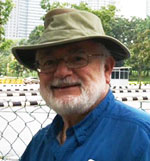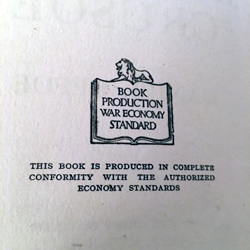© Oliver B. Pollak

 RICHMOND, California — The Jewish Book Council coined the phrase “The ProsenPeople” in 2011, an apt emblem worthy of exploration. The gift of literacy starts young. Parents read to children, then children read on their own. The sense of accomplishment evolved; crawling, toddling, walking, the alphabet, words, sentences, paragraphs, stories, chapters, books. In childhood book titles and illustrations were more important than concern for authorship and illustrators.
RICHMOND, California — The Jewish Book Council coined the phrase “The ProsenPeople” in 2011, an apt emblem worthy of exploration. The gift of literacy starts young. Parents read to children, then children read on their own. The sense of accomplishment evolved; crawling, toddling, walking, the alphabet, words, sentences, paragraphs, stories, chapters, books. In childhood book titles and illustrations were more important than concern for authorship and illustrators.
The earliest book given to me dates from 1950. Robinson Crusoe by Daniel Defoe with color plates by Jas E. M’Connell, part of Foulsham’s Boy and Girl Fiction Library (London by W. Foulsham & Co.). The book meeting the “Book Production War Economy Standard” a form of rationing in the printing industry, contained the statement, “This book is produced in complete conformity with the authorized economy standards.” My copy is inscribed in block letters, “With lots of love from Leslie. Christmas 1950.” I think this is Leslie Aronoff, a childhood friend in London. We lost touch in the early 1950s as Jewish refugees in England fanned out to Canada, Australia, South Africa, Israel, and America.
I did not read Robinson Crusoe nor a book of similar adventuresome ilk The Black Arrow, A Tale of the Two Roses by Robert Louis Stevenson, illustrated by N.C. Wyeth (New York: Charles Scribner’s Sons, 1942). I preferred to read books I selected like library copies of the Horatio Hornblower series by C. S. Forester. In adult life I devoured the Flashman series by George MacDonald Fraser.
I still have a slight aversion to receiving books as gifts, unless I’ve given hints to the giver on what I want to read. Giving a book places a time burden on the receiver. Beware of parents, uncles, aunts and friends bearing books as gifts. And, the ensuing guilt emanating from, “How did you like the book I gave you?”
Sung Under the Silver Umbrella, Poems for Young Children, selected by the Literature Committee of the Association for Childhood Education (New York: The Macmillan Co., first published in 1935, 1945, 211 pages) illustrated by Dorothy Lathrop, is still delightful; it has four Haiku.
Curious George books appeared in the 1940s. I read them though no copies survived. I certainly stuffed my children with Mischievous George the Monkey. Our grandchildren enjoy reading and watching his antics on the iPad. Oh for a big yellow hat. In 2005 I read The Journey of Curious George, The True Wartime Escape of Margaret and H.A. Rey by Louise Borden.
My wife Karen had some Little Golden Books that appeared during the 1940s. She received Grimms’ Fairy Tales by the Brothers Grimm (New York: Grosset & Dunlap, 1945), Illustrated by Fritz Kredel, in Canada. The title page is held in with yellowing scotch tape. Like many books of this period the year of publication, MCMXLV, copyright is in Roman numerals. She read Nancy Drew mysteries.
The role of imperial writers George E. Henty, Rudyard Kipling, Robert Ballantyne, and Rider Haggard on imperial masculinity and the British empire is incalculable.
My uncle Eric Bonner, a London bookseller, specialized in colonialism, The Borgzinners, Jewish German late 19th century immigrants to London became Bonner around 1914. I wrote “Eric M. Bonner, Africana Bookseller” (African Research & Documentation 81 (1999). In 1953 Eric gave me Speed, The Book of Racing and Records (Bowling Green Lane, London: Temple Press Ltd, 1950). He inscribed it, “Wishing you a Merry Christmas and a Happy New Year. 1950/1, Uncle Eric.” He knew what a seven-year old boy would enjoy. Automobiles, motor cycles, speed boats, sailing ships, trains, airplanes and bicycles, including “household name” Reg Harris, who won two silver medals at the London 1948 Olympics. The flight chapter contained a color picture of the de Havilland Comet jet airliner, which flew the 950 miles from London to Rome in just under two hours. Three fatal crashes caused by metal fatigue occurred after the book’s publication. I visited the Bonneville Salt Flats pictured in the book in 2016. My grandson took a liking to the book.
My mother says we went to the local public library in London. I was a nerdy reader at Audubon Junior High School, Susan Miller Dorsey High School and rode my Schwinn fat tire bicycle to the Angeles Mesa Branch Library in Leimert Park, near Crenshaw Blvd and West Slauson Avenue Oral and written book reports on 3×5 and 4×6 index cards were intimate to education.
Reading expands in adolescence. My immigrant parents aspiring to the middle class, belonged to the Book of the Month Club, subscribed to the Los Angeles Times, Readers Digest, Time Magazine, and the enigmatic Jewish themed Wisdom Magazine which appeared from 1956 to 1964 (“What is Wisdom,” Omaha Jewish Press, November 7, 2003, p. 21). I received Boy’s Life.
The Ugly American by William J. Lederer and Eugene Burdick arrived in 1958. It survives without dust jacket; the title has become a trope for representations of awkward and ambiguous American policy. About the same time I read my hitherto longest book about the siege of Stalingrad from the Junior High Library. It felt so sophisticated or bookish. In 1958 the Soviet’s heroic resistance to Nazis had occurred only a fifteen years earlier.
The Book Club swelled our shelves with reference books, classics and novels. Along with the educative 29 volume Funk & Wagnalls Encyclopedia and two-volume faux leather bound dictionary came Giovanni Boccaccio’s The Decameron. The controversial illustrator, Rockwell Kent, introduced me to pornography or erotica, before Playboy (My colleague William C. Pratt pointed out Kent’s altercations with Joseph McCarthy and the House Un-American Activities Committee). I own five different illustrated 20th century English translations of The Decameron and visited Certaldo in Tuscany where Boccaccio was born in 1313. The Terror of History (2011) by Teofilo Ruiz, who received the National Humanities Medal in 2011, transforms Boccaccio’s novel that dealt with the Black Death into darker compelling nonfiction.
My first used bookstore purchase, A Tale of Two Cities by Charles Dickens, occurred as a college freshman, and I did not read it. I started purchasing books on the Internet from Interloc and Alibris in the late 1990s, and from Abebooks in 2002; it went online in 1996 and was purchase by Amazon in 2008. Over the decades the library grew to about 7,000 volumes. Those of a certain age know the dilemma of storage and disposal.
*
Pollak, a professor emeritus of history at the University of Nebraska at Omaha, is a freelance writer now based in Richmond, California. He may be contacted via oliver.pollak@sdjewishworld.com